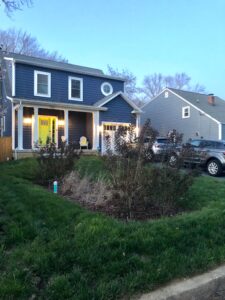What is a Rain Garden?
A rain garden, also known as a rainwater garden or bioswale, is a type of green infrastructure designed to manage stormwater runoff or what you might call “rain drainage.” It has a shallow depression, where surface water accumulates and gets filtered. The rainwater then slowly seeps into the ground, which helps in reducing flooding, pollution, and erosion.
You can construct a rain garden in any area with sufficient space for the water runoff to collect and a slope that allows for drainage. A rain garden also works by diverting or slowing down stormwater runoff from impervious surfaces such as roofs, driveways, or parking lots. This can be done by planting vegetation such as grasses or shrubs around the perimeter of the structures where runoff typically collects.
How does it Work?
Rain gardens are a great way to control water runoff and reduce the amount of polluted stormwater that reaches the ocean or other water bodies. They also provide habitat for wildlife, such as frogs and dragonflies, which are in danger of extinction due to the loss of wetland areas.
As we stated before, a rain garden is usually a shallow depression (in basic terms, a shallow excavated hole) in the ground that is filled with plants, rocks, and soil. Its primary purpose is to collect the water runoff from higher elevated areas and pull that water back into the ground before it leaves the property. The soil types will vary depending on where you live, but most rain gardens have a layer of sand or gravel at the bottom to help soak up and filter out pollutants. The plants in a rain garden will also vary depending on your climate, but they need to be able to withstand heavy rainfall, so nothing too delicate.
What are the Benefits of a Rain Garden?
There are numerous benefits to a rain garden, hence their popularity among property owners in both the spring and fall.
- A rain garden is a low-cost property project. Compared to other property projects like pavers, patios, and green roofs, a rain garden is far less expensive. Anywhere from $2,000-$10k.
- It can help curb water pollution. We already talked about this above, but the main component of a rainwater garden is that it can stop water pollution in your area by naturally filtering out chemicals through rock minerals and plant respiration cycles. Water runoff is the #1 cause of pollution in US Waterways.
- Rain gardens are also a great way to improve your home’s curb appeal! They provide a natural buffer between the street and the house, creating a more welcoming entrance.
- Create a space for pollinators-or don’t. Pollinators such as bats, bees, and butterflies struggle to survive in urban environments. They need flowers and water to stay alive and pollinate. Having a space for them to take a quick sip of water and pollinate is excellent for the environment and could be beneficial for other property plant life. Not a fan of bees? There are plenty of plants you can that will limit attraction.
- Nourish your property soil. Rain gardens pull water into your soils, mineral runoff, and plant contribution, which can help nourish your soils on site—an excellent way to start preparing for even more planting and soil relocation in the future.
What’s a Rain Garden Design?
The best way to design a rain garden is to consult with an expert in this field. You probably expected that response, and you aren’t jazzed about paying a contractor. Still, designing and building a rain garden is more than digging a hole and planting. The slope of your yard and soils heavily determine your rain garden. You DON’T want to purchase items only to discover that your rain garden isn’t helping control water runoff on your property.
A specialized contractor or landscape artist will help you with all design aspects, including what plants will work best for your local climate and soil conditions. Gardens can be designed in many different ways and can be as big or small as you want them to help maintain your costs and maintenance concerns.
Rain gardens are typically planted with native, water-loving plants that tolerate wet soil. These plants include sedges, rushes, and grasses. Depending on the size of your garden, they can also have rock designs and wood chips to help prevent flooding. More extensive rain gardens also can consist of small trees which do the heavy lifting in terms of soaking up water in flooded areas.
Here’s one of our favorite infographics about Rain Gardens:
Create Your Rain Garden Plan
Measuring slope, doing a soil test, and designing plant formations or tree planting methods are the main aspects of building your Rain Garden.
We have many resources to help make this project a complete success. You will want to connect with a contractor to get started on this process, but also, many government incentive programs help offset rain garden project costs. You can get paid back after completion (as long as you are eligible and qualify), but you can also inquire about a reduction in stormwater utility fees.
Rainplan offers hassle-free (we pay the contractor directly) payment plans if you want a little grace in how much upfront money you are willing to spend. We recommend that you create a free Rainplan to get started on this project so we can better understand your property and your goals, and we can share this plan with contractors when we approach them for bids.





